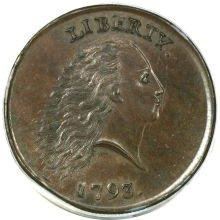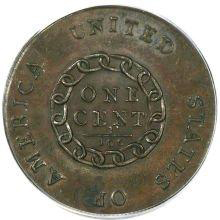 1793 Chain 1C Periods MS65 Brown PCGS. CAC. S-4, B-5, High R.3. Our EAC Grade MS60. The plate coin in Walter Breen's Encyclopedia of Early United States Cents 1793-1814. Periods follow the date and LIBERTY on the obverse of the S-4 Chain cent. The reverse, with AMERICA spelled in full, appears on S-2, S-3, S-4, and NC-1. Breen Die State II, early, with a faint crack from the rim at 7 o'clock into the hair, and another faint crack from the first, following the rim toward the date. A tiny planchet lamination obscures the second crack. A small planchet clip is also evident at the same location.
1793 Chain 1C Periods MS65 Brown PCGS. CAC. S-4, B-5, High R.3. Our EAC Grade MS60. The plate coin in Walter Breen's Encyclopedia of Early United States Cents 1793-1814. Periods follow the date and LIBERTY on the obverse of the S-4 Chain cent. The reverse, with AMERICA spelled in full, appears on S-2, S-3, S-4, and NC-1. Breen Die State II, early, with a faint crack from the rim at 7 o'clock into the hair, and another faint crack from the first, following the rim toward the date. A tiny planchet lamination obscures the second crack. A small planchet clip is also evident at the same location.
A small number of sensational Chain cents have survived for more than two centuries since they were coined in March 1793, including this example that carries a provenance to 1864. A sensational Gem, the Eliasberg specimen has a bold strike with excellent definition of the motifs, including the fine strands of Liberty's hair. The rim is bold and the centering is excellent. Every aspect of this superlative Chain cent is remarkable.
The rich olive and mahogany-brown surfaces are highly lustrous and virtually flawless. A small patch of reverse corrosion that was described in the Eliasberg catalog remains unchanged over the last 15 years, and it is completely stable, unlikely to change in the future.
 Comparative Descriptions
Comparative Descriptions
The five finest examples of S-4 in Bland's census carry a 19th century provenance. The opportunity to compare descriptions of a single coin through the years will give the 21st century numismatist an opportunity to better appreciate the work of 19th and 20th century numismatists.
In 1864, W. Elliot Woodward described this specimen as "Splendid, uncirculated, of the highest degree of rarity."
The next auction appearance was the December 1890 Thomas Cleneay sale, the Chapman brothers writing: "Beautiful sharp impression of rich light olive color. The finest specimen known of this variety which is much rarer than the preceding." The preceding lot was the Zanoni-Cleneay S-3 cent.
In the Mills catalog, the Chapman brothers wrote that the With Periods cent "is in uncirculated condition with a beautiful, lustrous, light olive surface."
A few years later, Henry Chapman wrote in the Earle catalog: "Sharp, even impression. The planchet on edge to left of date was not quite circular, and while it took the edge design, yet the coin is not a true circle at this point. However, it detracts so slightly that I feel this to be one of the finest specimens of this variety known. Its color is a lustrous, rich brown."
Just four years later, Henry Chapman found this coin on his desk again, this time as part of the Clarence S. Bement, Esq., collection: "Sharp, even impression with high edge. The planchet on edge to left of the date is not quite circular, though it has taken the edge bars, but it is hardly noticeable and even with this very slight defect it detracts so slightly that I feel this to be one of, if not the finest specimen known of this variety. Surface beautiful and of a rich, lustrous, light brown color."
This specimen soon found its way to William Cutler Atwater, whose collection was handled by B. Max Mehl in 1946. Mehl overlooked the planchet clip that had been described earlier: "Uncirculated with raised borders. Glossy medium brown surface. Bold impression. Mr. Atwater's catalog described it as 'superb.' From the famous Ellsworth collection. Extremely rare and valuable both as to variety and beautiful condition."
The present cataloger (Mark Borckardt) had the pleasure of describing this coin for the 1996 catalog of the Eliasberg collection, where it was graded MS64 Brown, writing: "Superbly detailed with excellent definition of all designs, including the highest points of the hair. Well centered. The letters are bifurcated on the obverse, slightly so on the reverse, an artifact of striking, due to planchet spreading. Obverse and reverse with high rims, as struck. Superb preservation without rim bruises or bumps. Lustrous brown surfaces with a tiny area of raised granularity at and to the right of F in OF. Struck on an incomplete planchet with very slight flattening of the edge at 7:00."
Sometime between May 1996 and July 2004, this specimen was certified MS65 Brown PCGS, and today it remains in a green-label holder. The cataloger for American Numismatic Rarities, the now defunct New Hampshire firm, wrote: "Sometimes in the course of numismatic events, a coin 'has it all,' with little else to be desired. Such an instance is here, with this simply incredible 1793 Chain cent, one of the most famous and rare of American coin types, combining the certification in gem grade, plus the incomparable pedigree of the Eliasberg Collection. Just about every adjective that you might care to apply would be relevant-marvelous, wonderful, and so on. You can add your own descriptions." The cataloger continued with a reprint of the Eliasberg description.
Census and Provenance
Just three examples of S-4 exist with claims to Mint State status. The finest piece is sometimes called "The Coin" and is the example illustrated in Walter Breen's Complete Encyclopedia of U.S. and Colonial Coins. "The Coin" is certified Specimen 67 Brown PCGS and carries a provenance back to Joseph Mickley who may have received it from the Mint Cabinet in trade for other numismatic items. Dr. Sheldon called the Mickley piece "possibly the most perfect Chain cent in existence."
The second finest example is the Parmelee coin that was illustrated in the 1991 Noyes Photo book. Although later opinions are lower, Dr. Sheldon called the Parmelee cent MS65 in the 1949 publication of Early American Cents.
The Eliasberg 1793 S-4 With Periods Chain cent, the second finest PCGS certified example, is considered the third finest of the S-4 cents, and carries a provenance back to 1864. In Early American Cents, Sheldon discussed the "recent sales" of examples that traded hands in the 1940s. This piece appeared in B. Max Mehl's sale of the Atwater Collection in 1946 but was overlooked by Sheldon in that discussion.
Prior to marketing of the Eliasberg collection in 1996, the early provenance was unknown. The Zanoni-Cleneay provenance ended with Clarence Bement. At the same time, the provenance of the Eliasberg coin began with James Ellsworth. They were listed as two different specimens, and the connection was only made when the Eliasberg coin was compared to the Bement plate.
There exists a gap in grades of the three pieces discussed here and the next tier of coins that include three or four XF examples. Current market levels for the top grade Chain cents are significant, although they seem low in comparison to other numismatic delicacies.
Ex: Fifth Semi-Annual Sale (W. Elliot Woodward, 10/1864), lot 603; Joseph Zanoni; Thomas Cleneay (S.H. & H. Chapman, 12/1890), lot 1795; Charles Steigerwalt; John G. Mills (S.H. & H. Chapman, 4/1904), lot 1227; George H. Earle, Jr. (Henry Chapman, 6/1912), lot 3355; Clarence S. Bement (Henry Chapman, 5/1916), lot 286; Col. James W. Ellsworth (3/1923); Wayte Raymond (1923); William Cutler Atwater (B. Max Mehl, 6/1946), lot 10; Louis E. Eliasberg, Sr.; Eliasberg Estate (Bowers and Merena, 5/1996), lot 487; Spectrum
© Heritage Auctions. All rights reserved. Used with permission.